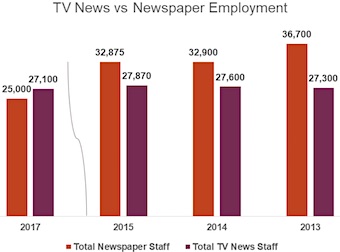Local TV newsrooms now employ more staffers than daily newspapers, according to a joint survey conducted by Hofstra University and broadcast and journalism organization Radio Television Digital News Association.
Reporting on the survey’s findings, the RTDNA in a statement said it’s the first time total local TV news employment has surpassed total daily newspaper employment in the annual survey’s 25-year history. The average TV newsroom has had more staffers than the average daily newspaper for several years now.
The 2018 RTDNA/Hofstra report shows that local TV newsroom employment currently stands at 27,100, just below the industry’s all-time high of 27,900 in 2001. By contrast, the report said total daily newspaper employment currently stands somewhere between 24,000 and 25,000.
 TV news versus newspaper employment. |
The report mentions that total local TV news jobs actually declined slightly in 2017, dipping 1.8 percent from 27,600 employees in 2016. Median newsroom size and average full-time total TV news staffing had dipped slightly as well. The report cited a continued consolidation of local TV news for much of this loss.
According to the report, nearly 90 percent of news directors said they expect staffing levels to either increase or remain roughly the same within the coming year. The report found that the largest share of newly-created newsrooms positions over the past year were jobs dedicated to digital platforms (web, social media or other digital media positions). Nearly 20 percent of newly-created positions at newsrooms were digital-focused, and digital roles overall (web/mobile writer or producer, social media producer or editor and digital content manager) increased an average of .2 percent, from 2.1 in 2016 to 2.3 in 2017. The report also found that various web/digital responsibilities have become increasingly integrated into existing newsroom roles.
Finally, the report found that average hiring at radio stations has remained virtually unchanged in the last year, as has radio web staffing positions. Non-commercial radio stations were three times more likely to expect to add new staff than their commercial counterparts.
The 2018 RTDNA/Hofstra University Survey was conducted during the fourth quarter of 2017 and polled 1,683 operating, non-satellite TV stations as well as a random sample of 3,542 radio stations. Tallied responses came from 1,333 television stations (79.2 percent) as well as 415 radio news directors and general managers representing 1,110 radio stations.


 Trump Media & Technology Group today reported a $58.2M net loss on $4.1M in 2023 revenues, a disclosure that drove its stock price down 22.6 percent to $47.96.
Trump Media & Technology Group today reported a $58.2M net loss on $4.1M in 2023 revenues, a disclosure that drove its stock price down 22.6 percent to $47.96. Barry Pollack, an attorney at Wall Street’s Harris St. Laurent & Wechsler, has registered Julian Assange as a client with the Justice Dept. “out of an abundance of caution.”
Barry Pollack, an attorney at Wall Street’s Harris St. Laurent & Wechsler, has registered Julian Assange as a client with the Justice Dept. “out of an abundance of caution.” Paramount Global to slash 800 jobs in what chief executive Bob Bakish calls part of an effort to “return the company to earnings growth"... Rolling Stone editor-in-chief Noah Shachtman is exiting at the end of the month due to disagreements with chief executive Gus Wenner over the direction the magazine is taking... The New York Times broke the $1 billion barrier in annual revenue from digital subscriptions in 2023... Press Forward is investing more than $500 million to strengthen local newsrooms.
Paramount Global to slash 800 jobs in what chief executive Bob Bakish calls part of an effort to “return the company to earnings growth"... Rolling Stone editor-in-chief Noah Shachtman is exiting at the end of the month due to disagreements with chief executive Gus Wenner over the direction the magazine is taking... The New York Times broke the $1 billion barrier in annual revenue from digital subscriptions in 2023... Press Forward is investing more than $500 million to strengthen local newsrooms. The majority of news articles are read within the first three days of publication, according to a recent report.
The majority of news articles are read within the first three days of publication, according to a recent report. The Los Angeles Times gives pink slips to 115 people or 20 percent of its newsroom staff... TIME is also laying off about 30 employees, which is approximately 15 percent of its editorial staff... The Baltimore Banner, which was launched by Stewart Bainum in 2022 after he failed to buy the Baltimore Sun, added 500 subscribers per day in the three days following Sinclair Broadcast Group's deal to purchase the Sun.
The Los Angeles Times gives pink slips to 115 people or 20 percent of its newsroom staff... TIME is also laying off about 30 employees, which is approximately 15 percent of its editorial staff... The Baltimore Banner, which was launched by Stewart Bainum in 2022 after he failed to buy the Baltimore Sun, added 500 subscribers per day in the three days following Sinclair Broadcast Group's deal to purchase the Sun.


 Have a comment? Send it to
Have a comment? Send it to 
No comments have been submitted for this story yet.